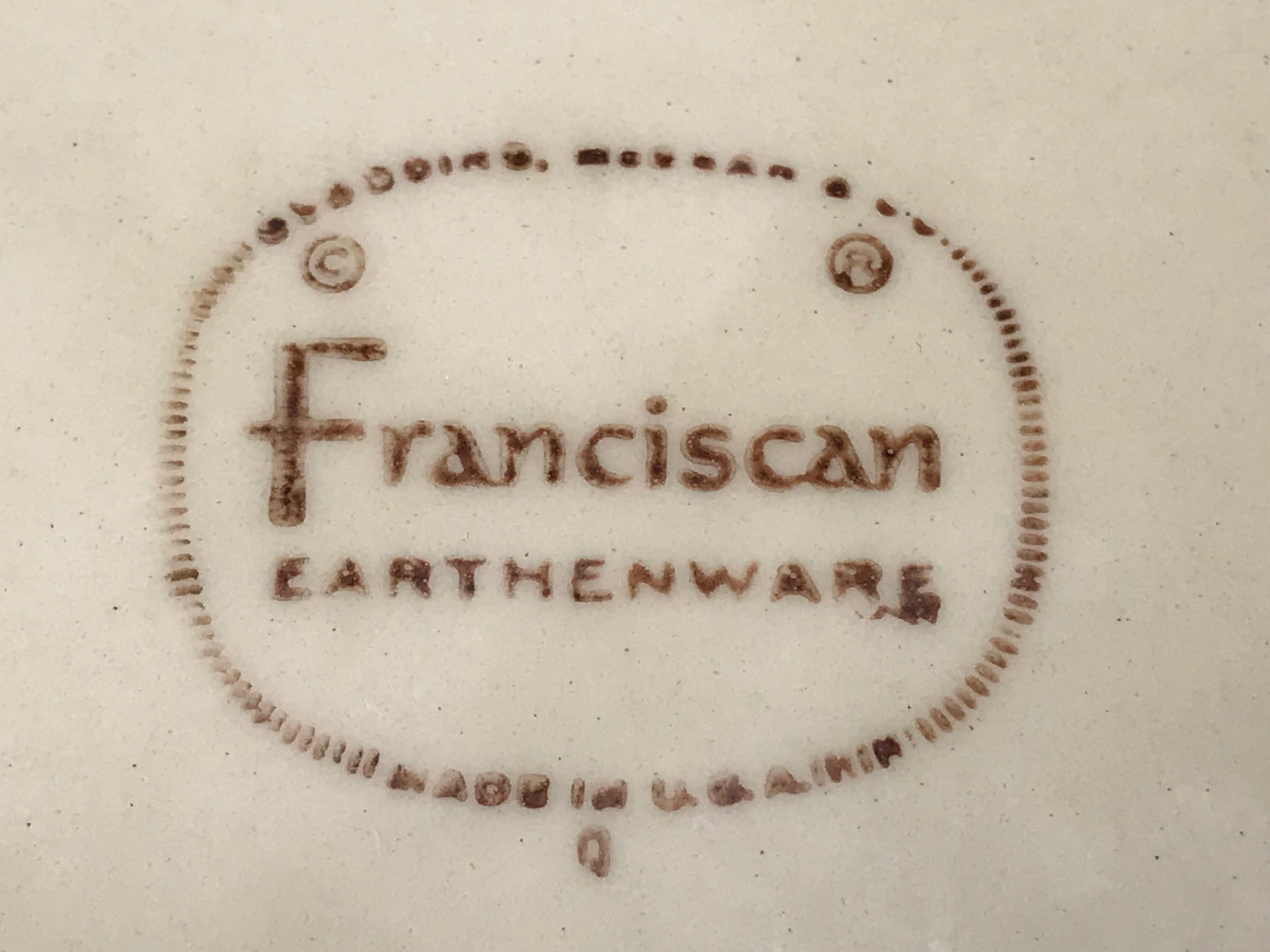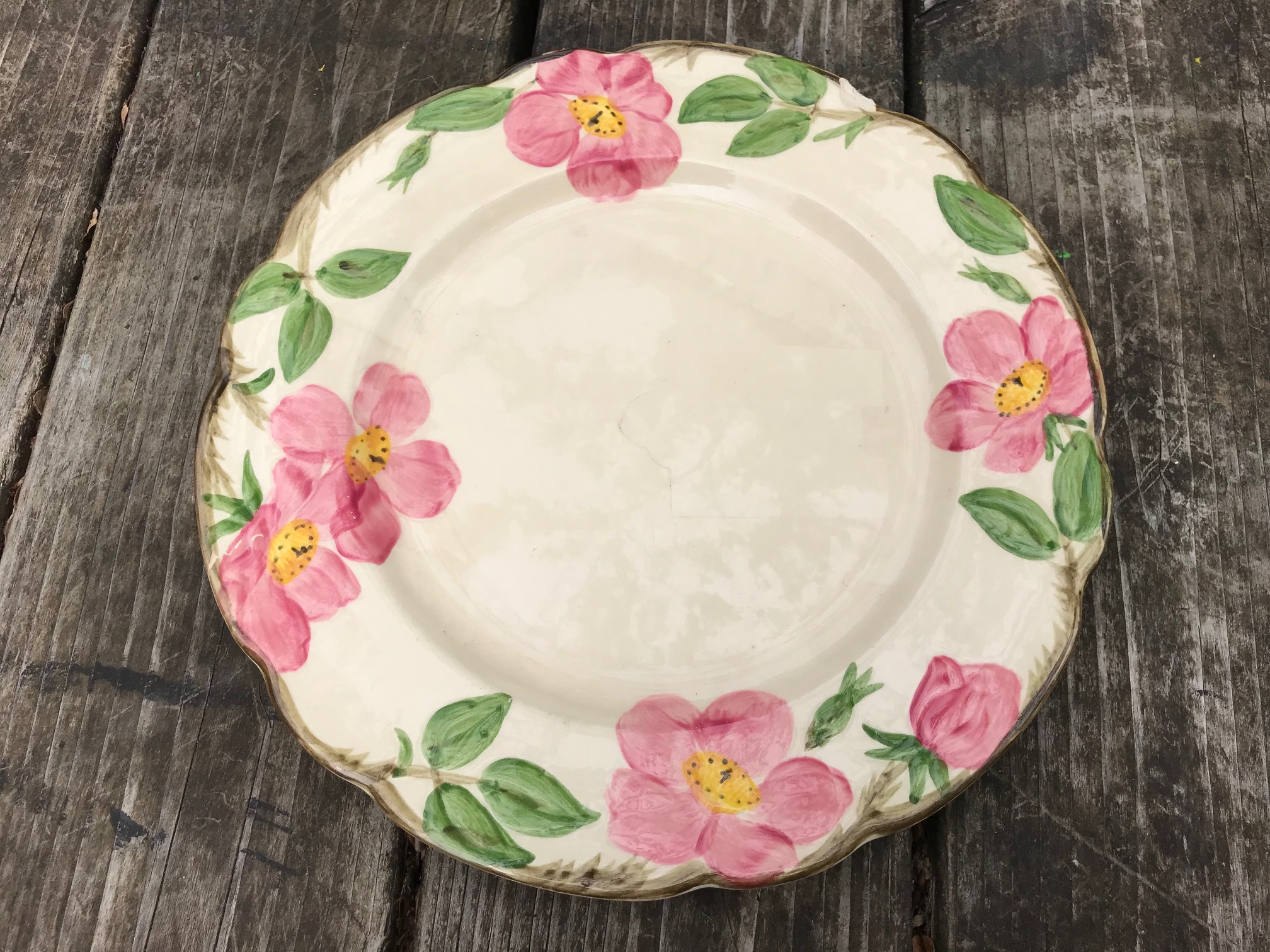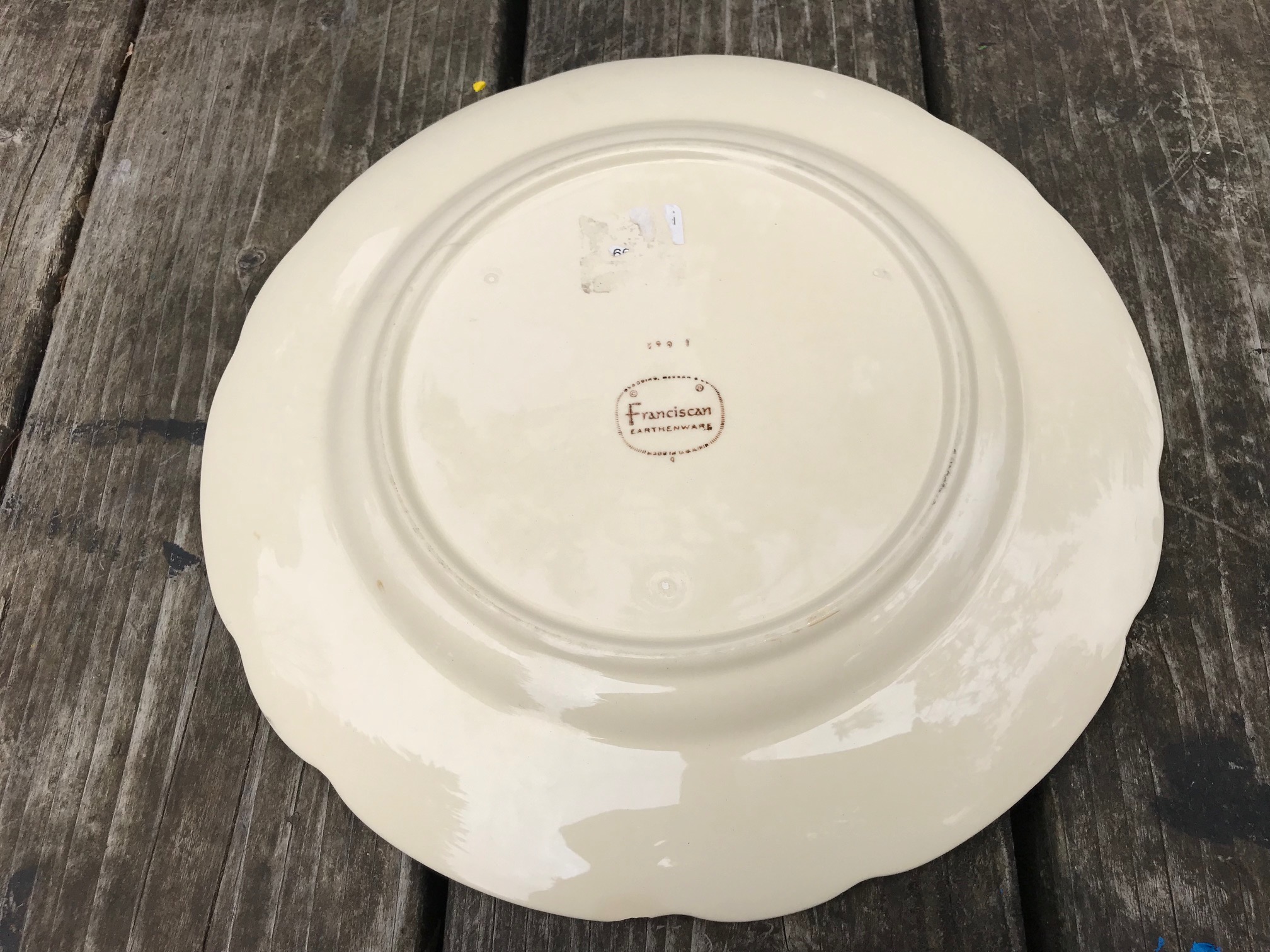Franciscan Desert Rose Earthenware China — c. 1941, Made in USA: 122,200 ppm Lead! (90 ppm is unsafe in kids’ items)
For those new to this website:
Tamara Rubin is a multiple-federal-award-winning independent advocate for childhood Lead poisoning prevention and consumer goods safety and a documentary filmmaker. She is also a mother of Lead-poisoned children (two of her sons were acutely Lead-poisoned in 2005). Since 2009, Tamara has been using XRF technology (a scientific method used by the U.S. Consumer Product Safety Commission) to test consumer goods for toxicants (specifically heavy metals — including Lead, Cadmium, Mercury, Antimony, and Arsenic). All test results reported on this website are science-based, accurate, and replicable. Items are tested multiple times to confirm the test results for each component tested. Tamara’s work was featured in Consumer Reports Magazine in February 2023 (March 2023 print edition).
Published: June 14, 2018
When this Franciscan Desert Rose Earthenware China (made in the USA, c. 1941 and later) was tested with an XRF instrument, it came in at 122,200 +/- 5,000 ppm Lead. The plate is negative for Cd (cadmium), As (arsenic), and Hg (mercury) — however, that is one heck of a lot of Lead to find in the glaze of a dish intended for food use (over 12% Lead)!
For context: There is currently no federal standard for an allowable limit of XRF detectable Lead in consumer goods like dishware. The only federal standard for XRF-detectable Lead is in items manufactured for and intended to be used by children. The current allowable limits are 90 ppm Lead in the coating and 100 ppm in the substrate (in the case of children’s dishes, this would be the ceramic base of the dish vs. the glaze).
Franciscan China is generally (and consistently) VERY high Lead. I highly recommend not having any in your home and not ever using them for food purposes. If you want to keep one piece on hand to remind you of your grandmother (or of a time gone by!), please consider putting it in a shadow box with a glass cover, and please hide a note behind the dish indicating that the item is high Lead (in case anyone ever breaks the piece out of the shadow box) and should not be used for food consumption purposes.
Hands should also be thoroughly washed after handling these dishes as they most often also test positive with a reactive agent test (like a LeadCheck swab), which means there is likely available Lead on the dish’s surface that can wear off easily onto your hands.
MOST dishes will NOT test positive with a LeadCheck swab, but handmade and handprinted Franciscan brand dishes tend to consistently test positive with this method. (Read more here: Can I test my dishes with a LeadCheck swab?)
As always, please let me know if you have any questions.
I love testing specific items that people want to know more about, but to do that, contributions are necessary to covering the cost of purchasing these items (as well as the related costs of testing these items).
If you want to support my independent consumer goods testing and Lead poisoning prevention advocacy work, please consider chipping in something (any amount helps) at this link.
IF you want me to test a specific item that will cost me less than $25 to purchase, please chip in at least $45 and send me a note about what you would like me to test. I will see if I can find it (there are a lot of antique shops on the blocks surrounding my home), and after I can test it (which sometimes takes me between 4 and 8 weeks), I will publish the test results here the website to share with everyone.
If the item turns out to be Lead-free, I can either offer it as a prize for a free giveaway on Facebook or send it to you (if you can help with shipping). If the item is leaded and is a popular and known brand, I would love to hold onto it for my “Museum of Lead” (and to use in an upcoming book!).
Thank you!
Tamara Rubin
#LeadSafeMama
Never Miss an Important Article Again!
Join our Email List












This is a bummer! My mom has a whole collection of these dishes and while they are beautiful, I’m surprised they have a lot of lead! She won’t ever give them up and they are stored in a hutch as decoration, but I will have to remember not to keep any when she passes away. I love your website and all the work you have done by the way. I’m new to researching and changing my dishes so that my house is BPA and lead-free and your articles have helped so much! If only our country cared about this more. Keep at it!
Thank you so much!
I’m horrified reading this. Very worried. We have used these dishes for probably 10 years now. My husband and I. I’m freaking out. I threw them away.
You should definitely get a blood lead test right away if you can. You may or may not test positive depending on the low threshold of detection for the lab you use for testing. Read the following articles and then call your doctor:
1. https://tamararubin.com/2019/02/blood-lead-testing-please-get-everyone-in-the-family-tested-since-you-have-been-living-in-a-house-with-high-lead-paint/
2. https://tamararubin.com/2021/06/but-is-this-dish-or-toy-or-lamp-or-vitamin-or-piece-of-jewelry-or-tibetan-brass-singing-bowl-actually-going-to-poison-me-and-how-would-that-happen-exactly/
3. https://tamararubin.com/2021/12/my-childs-lead-test-came-back-as/
4. https://tamararubin.com/2021/07/how-quickly-after-exposure-is-lead-detectable-in-my-childs-blood-what-is-the-half-life-of-lead-in-blood-how-long-does-lead-stay-in-the-body/
5. https://tamararubin.com/2017/01/what-is-the-impact-of-lead-poisoning-in-adults-including-college-age-students/
Tamara
Ohhh, I’m so disappointed to find this out! (But also grateful!!!) We have a huge collection of this pattern. Thanks for posting!
Hi Gabriela, the lead levels in the Franciscan patterns are very concerning. I wouldn’t use them for any food purposes ever. Maybe put some in a decorative shadow box and get rid of the rest? Read this post for my thoughts on that: https://tamararubin.com/2013/11/what-should-i-do-with-my-lead-contaminated-dishes-to-toss-or-not-to-toss/
Hi Tamara,
my wife just inherited a collection of these Franciscan Desert Rose Earthenware dishes from her deceased grandmother who had them for several years. It looks like there are multiple different years and locations of manufacture including England, USA, and California labeled on the plate. Some say 1995 and oven and dishwasher safe. I guess my question is do they all contain lead? Should we test with a swab? In the meantime I think we should not use as we have young children in the house. I appreciate your thoughts.
Michael
Hi Michael, In my experience they ALL contain high lead and the Rose pattern appears to be a lower-fire pottery than some of their other patterns and regardless of the year of manufacture I would avoid them altogether. If you want to send me a saucer to test (so I can report one more set of results on my blog) I could do that. Let me know if that’s of interest. Do the ones of your set all appear to be from the same year? Or is it your set in particular that is from multiple years? If you have a chipped one that I could hold onto for my collection (for my “Museum of Lead”) after testing that would be excellent. I would especially love to test one that is marked with the year”1995″, as I have not tested one with that marking that I recall! My e-mail is TamaraRubin@mac.com – to follow up.
My set were bought brand new in the mid 90s. I remember picking them because Bon Marche had a sign that they were lead free.
If they had a sign that said “Lead-free” they were likely labeled that way because they were “non-leaching” and not actually Lead-free… although I would have to test to know for sure. The thing is that if they were non-leaching at the time of manufacture – that does not necessarily mean they are non-leaching throughout their life. Here’s a post with more information about that: https://tamararubin.com/topics/does-vintage-and-new-functional-pottery-and-dishware-have-unsafe-levels-of-lead/
Thank you for commenting Deanna!
Tamara
My mother got these when they were married at age 20. We ate every meal growing up and my parents continued to use them for their entire life. We, the kids only used them occasionally after that. My mother passed away at 83 and my dad at the age of 90. He really didn’t have any illness. When my dad died the glaze was almost completely worn off of the plates. My brother had his lead levels checked frequently because he worked near a lead smelter. His levels initially were within normal limits and he had moved away from home st the time. Gradually his level climbed as did one of his children so he quit his job.
I just mention this because it is interesting how these levels of lead in pottery or other kitchenware might translate into actually absorbing it. What other factors might increase absorption(heat or acidic foods?) or decrease it.
Hi Sara! Thank you for commenting and for sharing your story.
A diet high in garlic has been shown to help the body eliminate lead, you can read more about that here (they did a study with chickens!): https://tamararubin.com/2017/01/natural-chelation/
Tamara
Sara – one more thing you might find interesting / revenant… this story is about a little boy who was poisoned by his vintage dishes (at his grandmother’s house): https://tamararubin.com/2018/04/a-short-story-of-a-small-vintage-ceramic-bowl-from-wisconsin-and-a-boy-that-was-poisoned/
Tamara
Did you mean to say highlead levels on the dishes did not translate to absorption? Seems your parents lived full lives. I bought a home lead test kit and found several plates positive. I set those aside, but the newer ones ie 1995 look good for use and tested negative. Can I get the positive ones reglazed and I wonder if that will be protective enough for kids. My wife really wants to use them as our daily dishes. Appreciate your input.
Did you mean to say highlead levels on the dishes did not translate to absorption? Seems your parents lived full lives. I bought a home lead test kit and found several plates positive. I set those aside, but the newer ones ie 1995 look good for use and tested negative. Can I get the positive ones reglazed and I wonder if that will be protective enough for kids. My wife really wants to use them as our daily dishes. Appreciate your input.
Thanks
Could you tell me if the Apple or peach in Franciscan ware is high in lead . Thank you.
All Franciscan items I have ever tested (in all designs) have been positive for very high levels of Lead. This is especially true of the Franciscan Apple pieces which also test positive with a swab test.
Here’s a link to a post with Franciscan Apple test results: https://tamararubin.com/2019/01/vintage-c-1950s-franciscan-apple-earthenware-sugar-bowl-161200-ppm-lead-franciscan-pottery-pieces-are-not-safe-for-food-use/
Thank you for commenting.
Tamara
I have the solid color square shaped set. Half of them are mustard yellow, the other half of them are medium Gray. Any info on Franciscanware, solid color?
Do you know if the version from England is safe?
Eleine,
I have not tested ANY Franciscan pottery that was negative for Lead. Most “Made in England” pottery and china that I have tested has been very high Lead as well. People assume “Made in England” means something in terms of quality and safety – but it simply does not.
Tamara
I have my grandmother’s Franciscan Desert Rose dishes. How would I dispose of them correctly since they have lead? I am truly devastated to hear this. I LOVE My grandma’s dishes.
Could you please tell me the dishes to buy on Amazon that are safe. You mentioned them before but I can’t find that post. Thank you for your efforts and help.
Hi Paula – here’s the post with the dishes I have in my home: https://tamararubin.com/2016/12/ask-tamara-what-dishes-do-you-use-in-your-home-which-dishes-are-lead-free/
Here’s my direct Amazon affiliate link to my favorite dishes (note: they are usually cheaper at Target when they have them!): https://amzn.to/2Ko2xnr
Tamara
I inherited a collection of dishes called “Starburst”. They are packed up but i’m pretty sure they are Franciscan. Is this correct and have you ever tested any?
Hello! have you tested Fransiscan “Small Fruits” pattern (made in California) for lead? f not, I have a chipped dinner plate with your name on it!
Thanks!
Hello, I have many sets of Desert Rose. The original pieces were from my grandmother. Since inheriting, I have been adding more and more pieces. Could you please tell me how to read the information on the back of the pieces? For instance, do the numbers mean when the pieces were made? I plan to get rid of all pieces produced prior to 1990.
Thank you! Candi
Hi, I inherited a large set of the desert rose. I just unpacked it, which has been packed up in my garage for the last year. I set it on part of my dining table as I was going to just display it in my China cabinet and never use it. My China cabinet has glass doors. Would this be ok..If it’s just for display? Or will it contaminate other things on other shelves in that cabinet? Just wondering if the lead will contaminate air or if it’s just a contact issue. Also, how should I clean the area where I unpacked?! I did all of this and then decided to look it up now I’m worried. I wouldn’t bombard you with this but I’m not sure where else to look for this info
I just purchased an old set to use..but didnt know about the lead issue..thank you for the info..do you know how to figure out what year the pieces were made???
All examples from this brand that I have tested have been very high lead and NONE should be considered safe to eat off of. If you want to be 100% sure you could send me a saucer – here’s the post about that (but I don’t feel it is necessary):
https://tamararubin.com/2019/08/tamara-can-i-send-you-one-of-my-dishes-to-test-for-lead/
Please check out the other “Franciscan” posts on my blog:
https://tamararubin.com/category/franciscan/
Thank you for commenting. Please let me know if you have any other questions.
Tamara
Hello, with a reply to BarbaraAnderson about her question on how to figure out when her dinnerware
pieces were made. You can find that information online- do a search for ‘Franciscan china markings’ (or something close to that), and multiple sites should come up. Look thru those until you find one that shows
all the varied markings Franciscan used; those examples should also show the years/range of years that each marking was used. Also, keep in mind that Franciscan made different qualities of dinnerware; some were everyday pottery, and some were very fine high-end china; each type had different glazes. That said, I’m not
sure if ALL their glazes are problematic, or if just particular types of china, or specific years, are problematic.
Maybe Tamara can speak to that, and if she already has addressed it and I’ve not yet seen it, will get to it :0)
I just received a set of Franciscan dishware
It is all made in California. I am not sure of the year. Is this safe then?
Thank you in advance. ♥️♥️
No – generally Franciscan is never safe. Which pattern is it? I would not consider any Franciscan products from any years or any country of origin to be safe for food use purposes.
Here’s the Franciscan category link on the blog: https://tamararubin.com/category/franciscan/
Thanks for commenting.
Tamara
I have a set of my mom’s Franciscan China in the Freemont pattern. Is this also high in lead?
Hi,
Do you know if the Made in China Desert Rose is safe?
Thanks!
Thanks for saving me from an auction purchase! No thank you.
I just passed my mother-in-law’s set to my daughter… Only to find this blog! Oh dear. How would you advise disposing of… I don’t really want to pass it on to anyone else.
Hi Tamara!
What amazing work you are doing. I just inherited a set from my late father, who inherited from his mother. I am glad I happened to decide to google the name.
I have searched your site extensively and haven’t found if you tested the Francisiscan desert rose GLASSES. They look like wine goblets (the one’s I have) and are painted on the outside (no paint on the inside) and I can see and feel the paint. It does not have a glaze/coating over them, that I can tell. Is the lead found in the clear glaze that coats the pottery? Or has the lead been found in the actual paint itself? Do you think I can keep the goblets and say bye to the plates? The goblets would be used so rarely, maybe Christmas etc…. Thank you for your time.
Tamara I nearly had a heart attack when I saw a woman post a picture of her toddler granddaughter eating macaroni off of desert rose in a table setting group on FB! I’m sure she’s not aware of the lead, but I so want to reach out to her in a friendly, non-judgmental way. Any suggestions on how I can do this so she doesn’t feel bad or think I’m being a snob? So hard for me to stay silent on this…
Same thing when I see people doing milk bath photo sessions with their babies in galvanized metal buckets…♀️♀️